Samsung: Market Segments, Decision Making, and Competitive Analysis
VerifiedAdded on 2021/01/03
|12
|3555
|349
Report
AI Summary
This report provides a comprehensive analysis of Samsung's market segmentation and decision-making processes within the telecommunications industry. It begins by describing the industry market, evaluating current trends in growth, profitability, and the macro environment using PESTLE factors. The report then examines the nature of competition through a SWOT analysis. Further, it identifies Samsung's major markets, differentiating between primary and secondary target markets. The report explores the involvement of the primary segment in Samsung's decision-making, and concludes with a positioning map considering customer involvement, competition, and the primary segment's influence. The report underscores the importance of understanding consumer behavior, product development, and customer service in shaping Samsung's strategies and maintaining its competitive edge in the global market. The report also includes analysis of Samsung's strengths and weaknesses compared to its competitors.

MARKETS SEGMENTS
AND DECISION MAKING
AND DECISION MAKING
Paraphrase This Document
Need a fresh take? Get an instant paraphrase of this document with our AI Paraphraser
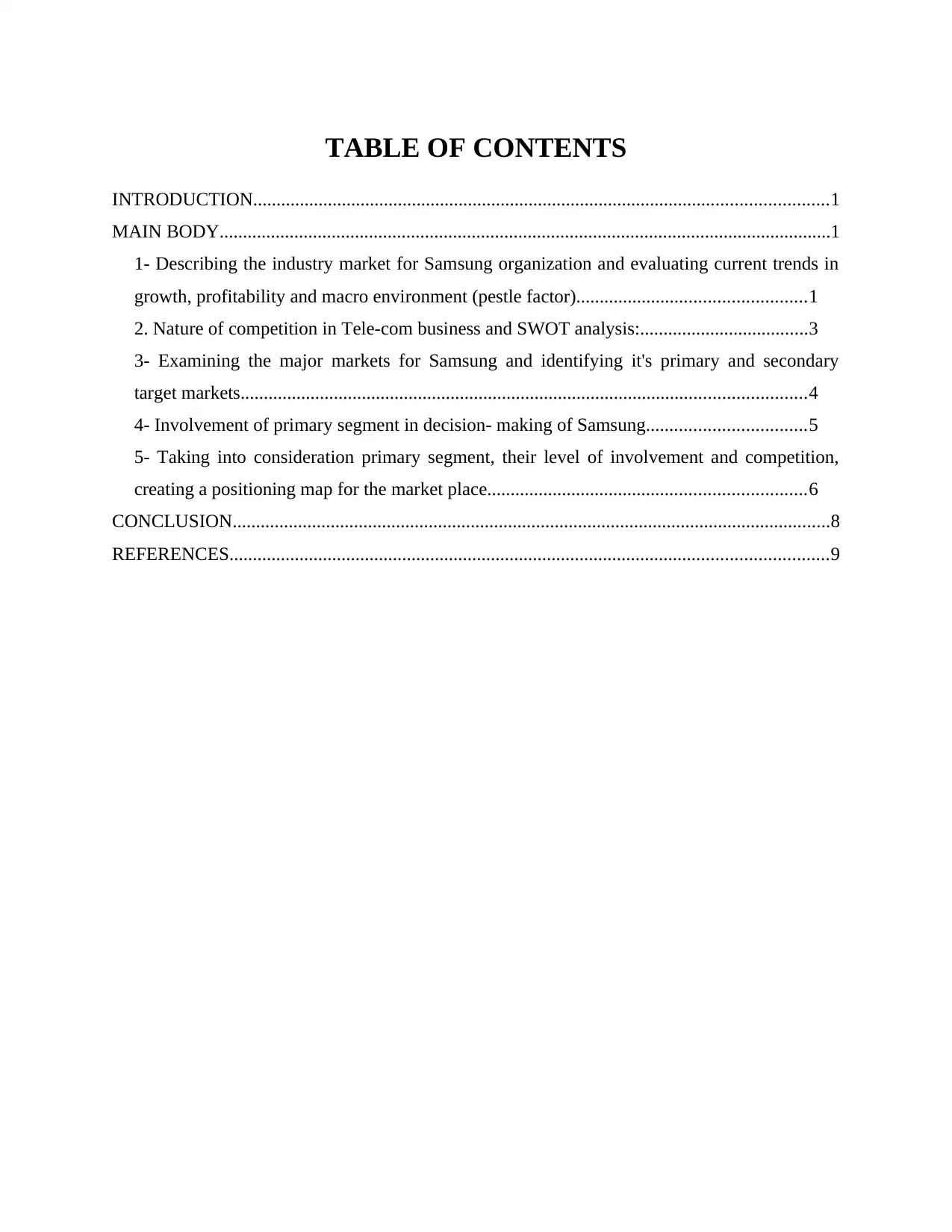
TABLE OF CONTENTS
INTRODUCTION...........................................................................................................................1
MAIN BODY...................................................................................................................................1
1- Describing the industry market for Samsung organization and evaluating current trends in
growth, profitability and macro environment (pestle factor).................................................1
2. Nature of competition in Tele-com business and SWOT analysis:....................................3
3- Examining the major markets for Samsung and identifying it's primary and secondary
target markets.........................................................................................................................4
4- Involvement of primary segment in decision- making of Samsung..................................5
5- Taking into consideration primary segment, their level of involvement and competition,
creating a positioning map for the market place....................................................................6
CONCLUSION................................................................................................................................8
REFERENCES................................................................................................................................9
INTRODUCTION...........................................................................................................................1
MAIN BODY...................................................................................................................................1
1- Describing the industry market for Samsung organization and evaluating current trends in
growth, profitability and macro environment (pestle factor).................................................1
2. Nature of competition in Tele-com business and SWOT analysis:....................................3
3- Examining the major markets for Samsung and identifying it's primary and secondary
target markets.........................................................................................................................4
4- Involvement of primary segment in decision- making of Samsung..................................5
5- Taking into consideration primary segment, their level of involvement and competition,
creating a positioning map for the market place....................................................................6
CONCLUSION................................................................................................................................8
REFERENCES................................................................................................................................9
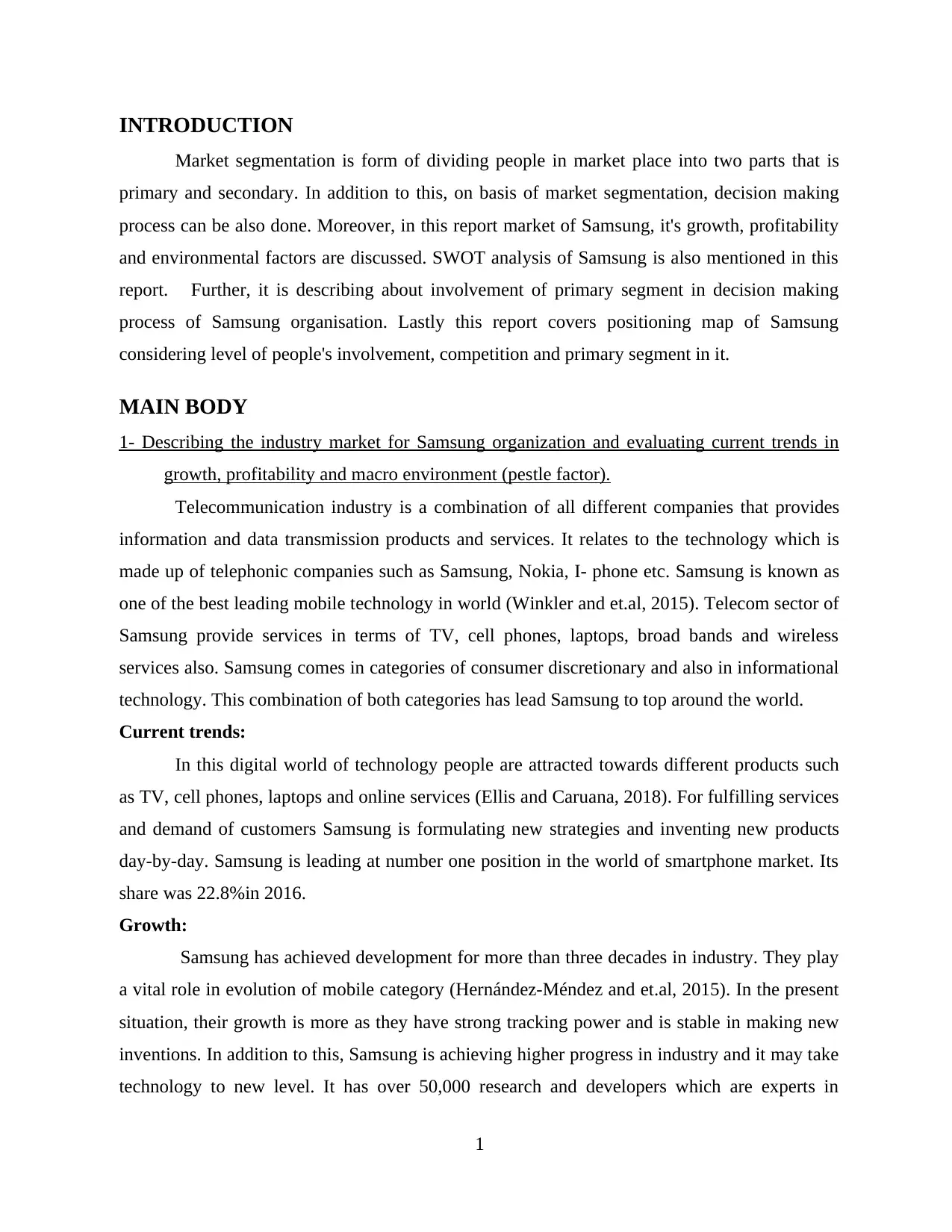
INTRODUCTION
Market segmentation is form of dividing people in market place into two parts that is
primary and secondary. In addition to this, on basis of market segmentation, decision making
process can be also done. Moreover, in this report market of Samsung, it's growth, profitability
and environmental factors are discussed. SWOT analysis of Samsung is also mentioned in this
report. Further, it is describing about involvement of primary segment in decision making
process of Samsung organisation. Lastly this report covers positioning map of Samsung
considering level of people's involvement, competition and primary segment in it.
MAIN BODY
1- Describing the industry market for Samsung organization and evaluating current trends in
growth, profitability and macro environment (pestle factor).
Telecommunication industry is a combination of all different companies that provides
information and data transmission products and services. It relates to the technology which is
made up of telephonic companies such as Samsung, Nokia, I- phone etc. Samsung is known as
one of the best leading mobile technology in world (Winkler and et.al, 2015). Telecom sector of
Samsung provide services in terms of TV, cell phones, laptops, broad bands and wireless
services also. Samsung comes in categories of consumer discretionary and also in informational
technology. This combination of both categories has lead Samsung to top around the world.
Current trends:
In this digital world of technology people are attracted towards different products such
as TV, cell phones, laptops and online services (Ellis and Caruana, 2018). For fulfilling services
and demand of customers Samsung is formulating new strategies and inventing new products
day-by-day. Samsung is leading at number one position in the world of smartphone market. Its
share was 22.8%in 2016.
Growth:
Samsung has achieved development for more than three decades in industry. They play
a vital role in evolution of mobile category (Hernández-Méndez and et.al, 2015). In the present
situation, their growth is more as they have strong tracking power and is stable in making new
inventions. In addition to this, Samsung is achieving higher progress in industry and it may take
technology to new level. It has over 50,000 research and developers which are experts in
1
Market segmentation is form of dividing people in market place into two parts that is
primary and secondary. In addition to this, on basis of market segmentation, decision making
process can be also done. Moreover, in this report market of Samsung, it's growth, profitability
and environmental factors are discussed. SWOT analysis of Samsung is also mentioned in this
report. Further, it is describing about involvement of primary segment in decision making
process of Samsung organisation. Lastly this report covers positioning map of Samsung
considering level of people's involvement, competition and primary segment in it.
MAIN BODY
1- Describing the industry market for Samsung organization and evaluating current trends in
growth, profitability and macro environment (pestle factor).
Telecommunication industry is a combination of all different companies that provides
information and data transmission products and services. It relates to the technology which is
made up of telephonic companies such as Samsung, Nokia, I- phone etc. Samsung is known as
one of the best leading mobile technology in world (Winkler and et.al, 2015). Telecom sector of
Samsung provide services in terms of TV, cell phones, laptops, broad bands and wireless
services also. Samsung comes in categories of consumer discretionary and also in informational
technology. This combination of both categories has lead Samsung to top around the world.
Current trends:
In this digital world of technology people are attracted towards different products such
as TV, cell phones, laptops and online services (Ellis and Caruana, 2018). For fulfilling services
and demand of customers Samsung is formulating new strategies and inventing new products
day-by-day. Samsung is leading at number one position in the world of smartphone market. Its
share was 22.8%in 2016.
Growth:
Samsung has achieved development for more than three decades in industry. They play
a vital role in evolution of mobile category (Hernández-Méndez and et.al, 2015). In the present
situation, their growth is more as they have strong tracking power and is stable in making new
inventions. In addition to this, Samsung is achieving higher progress in industry and it may take
technology to new level. It has over 50,000 research and developers which are experts in
1
⊘ This is a preview!⊘
Do you want full access?
Subscribe today to unlock all pages.

Trusted by 1+ million students worldwide
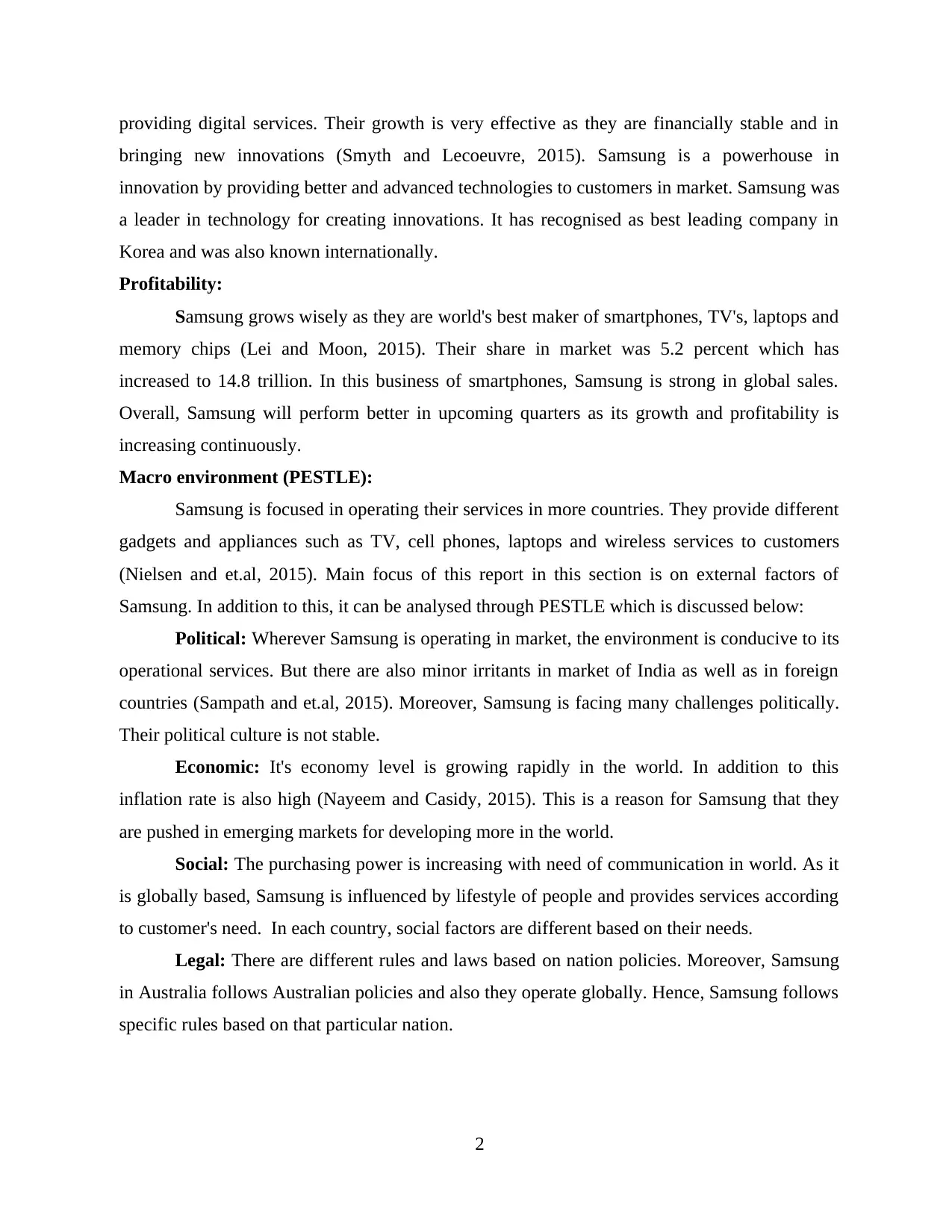
providing digital services. Their growth is very effective as they are financially stable and in
bringing new innovations (Smyth and Lecoeuvre, 2015). Samsung is a powerhouse in
innovation by providing better and advanced technologies to customers in market. Samsung was
a leader in technology for creating innovations. It has recognised as best leading company in
Korea and was also known internationally.
Profitability:
Samsung grows wisely as they are world's best maker of smartphones, TV's, laptops and
memory chips (Lei and Moon, 2015). Their share in market was 5.2 percent which has
increased to 14.8 trillion. In this business of smartphones, Samsung is strong in global sales.
Overall, Samsung will perform better in upcoming quarters as its growth and profitability is
increasing continuously.
Macro environment (PESTLE):
Samsung is focused in operating their services in more countries. They provide different
gadgets and appliances such as TV, cell phones, laptops and wireless services to customers
(Nielsen and et.al, 2015). Main focus of this report in this section is on external factors of
Samsung. In addition to this, it can be analysed through PESTLE which is discussed below:
Political: Wherever Samsung is operating in market, the environment is conducive to its
operational services. But there are also minor irritants in market of India as well as in foreign
countries (Sampath and et.al, 2015). Moreover, Samsung is facing many challenges politically.
Their political culture is not stable.
Economic: It's economy level is growing rapidly in the world. In addition to this
inflation rate is also high (Nayeem and Casidy, 2015). This is a reason for Samsung that they
are pushed in emerging markets for developing more in the world.
Social: The purchasing power is increasing with need of communication in world. As it
is globally based, Samsung is influenced by lifestyle of people and provides services according
to customer's need. In each country, social factors are different based on their needs.
Legal: There are different rules and laws based on nation policies. Moreover, Samsung
in Australia follows Australian policies and also they operate globally. Hence, Samsung follows
specific rules based on that particular nation.
2
bringing new innovations (Smyth and Lecoeuvre, 2015). Samsung is a powerhouse in
innovation by providing better and advanced technologies to customers in market. Samsung was
a leader in technology for creating innovations. It has recognised as best leading company in
Korea and was also known internationally.
Profitability:
Samsung grows wisely as they are world's best maker of smartphones, TV's, laptops and
memory chips (Lei and Moon, 2015). Their share in market was 5.2 percent which has
increased to 14.8 trillion. In this business of smartphones, Samsung is strong in global sales.
Overall, Samsung will perform better in upcoming quarters as its growth and profitability is
increasing continuously.
Macro environment (PESTLE):
Samsung is focused in operating their services in more countries. They provide different
gadgets and appliances such as TV, cell phones, laptops and wireless services to customers
(Nielsen and et.al, 2015). Main focus of this report in this section is on external factors of
Samsung. In addition to this, it can be analysed through PESTLE which is discussed below:
Political: Wherever Samsung is operating in market, the environment is conducive to its
operational services. But there are also minor irritants in market of India as well as in foreign
countries (Sampath and et.al, 2015). Moreover, Samsung is facing many challenges politically.
Their political culture is not stable.
Economic: It's economy level is growing rapidly in the world. In addition to this
inflation rate is also high (Nayeem and Casidy, 2015). This is a reason for Samsung that they
are pushed in emerging markets for developing more in the world.
Social: The purchasing power is increasing with need of communication in world. As it
is globally based, Samsung is influenced by lifestyle of people and provides services according
to customer's need. In each country, social factors are different based on their needs.
Legal: There are different rules and laws based on nation policies. Moreover, Samsung
in Australia follows Australian policies and also they operate globally. Hence, Samsung follows
specific rules based on that particular nation.
2
Paraphrase This Document
Need a fresh take? Get an instant paraphrase of this document with our AI Paraphraser

Environmental: Samsung products are sold widely and they make their products in
environmentally responsible way. They must be sure that their products are not compromised by
customers but should make customers happy.
2. Nature of competition in Tele-com business and SWOT analysis:
Nature of competition in telecommunication industry: In this modern world of technology,
telecommunication is growing faster over past two decades. There has been an advance
innovation in fibre optics, wireless, cell phones, laptops and signal processing units. In relation
to its nature, people are attracted day-by-day to use new technologies (Narasimhan, Srinivasan
and Sudhir, 2015). Competition in market lowers rate and also promotes higher usage of the
product and services. In addition to this, market growth is increasing with the increase in
technologies. The conditions of market are continuously transforming telecommunication
industry. Changes in technology and government rules also introduces competition in industry
through which demand of Samsung products and services increases in market.
SWOT Analysis:
Strengths: Samsung is top leading smartphone company which is expert in innovations
and inventing new designs. One of its strength is their low production cost. They have largest
share in smartphones sales in market. Samsung invests more in research and development
processes. Their products are sold environment- friendly in market.
Weakness: Their profit margin is very low in market which decreases their profitability
of company. In addition to this, they perform in manufacturing too many products such that
they can't focus properly on each product particularly.
Opportunities: They get the opportunity in expanding their products and services to
other countries also. They also get a chance in investing more on advertising its product in an
industry. As the demand of goods is increasing they also get a better opportunity in maintaining
their quality in electronics (Schaper, 2016). They are eligible in growing in Asian economies
which helps them in increasing their potential in other countries.
Threats: Continuous and rapid change in technology can become a threat for the
industry. Samsung have their competitors like Apple and Motorola which can be a threat for
them. As they decline in margins on hardware production has become a threat for them. Threats
from Chinese products arises which decreases their efficiency.
3
environmentally responsible way. They must be sure that their products are not compromised by
customers but should make customers happy.
2. Nature of competition in Tele-com business and SWOT analysis:
Nature of competition in telecommunication industry: In this modern world of technology,
telecommunication is growing faster over past two decades. There has been an advance
innovation in fibre optics, wireless, cell phones, laptops and signal processing units. In relation
to its nature, people are attracted day-by-day to use new technologies (Narasimhan, Srinivasan
and Sudhir, 2015). Competition in market lowers rate and also promotes higher usage of the
product and services. In addition to this, market growth is increasing with the increase in
technologies. The conditions of market are continuously transforming telecommunication
industry. Changes in technology and government rules also introduces competition in industry
through which demand of Samsung products and services increases in market.
SWOT Analysis:
Strengths: Samsung is top leading smartphone company which is expert in innovations
and inventing new designs. One of its strength is their low production cost. They have largest
share in smartphones sales in market. Samsung invests more in research and development
processes. Their products are sold environment- friendly in market.
Weakness: Their profit margin is very low in market which decreases their profitability
of company. In addition to this, they perform in manufacturing too many products such that
they can't focus properly on each product particularly.
Opportunities: They get the opportunity in expanding their products and services to
other countries also. They also get a chance in investing more on advertising its product in an
industry. As the demand of goods is increasing they also get a better opportunity in maintaining
their quality in electronics (Schaper, 2016). They are eligible in growing in Asian economies
which helps them in increasing their potential in other countries.
Threats: Continuous and rapid change in technology can become a threat for the
industry. Samsung have their competitors like Apple and Motorola which can be a threat for
them. As they decline in margins on hardware production has become a threat for them. Threats
from Chinese products arises which decreases their efficiency.
3
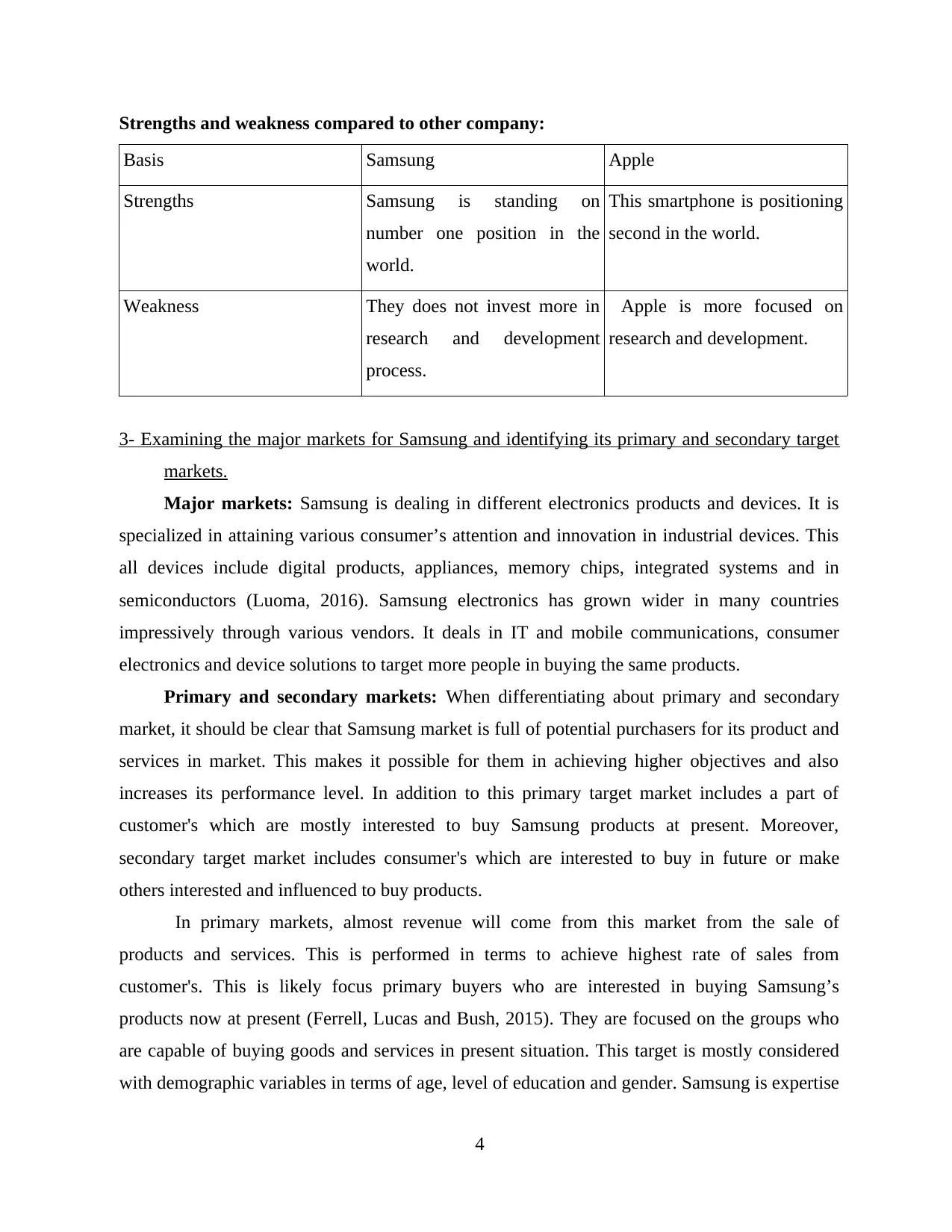
Strengths and weakness compared to other company:
Basis Samsung Apple
Strengths Samsung is standing on
number one position in the
world.
This smartphone is positioning
second in the world.
Weakness They does not invest more in
research and development
process.
Apple is more focused on
research and development.
3- Examining the major markets for Samsung and identifying its primary and secondary target
markets.
Major markets: Samsung is dealing in different electronics products and devices. It is
specialized in attaining various consumer’s attention and innovation in industrial devices. This
all devices include digital products, appliances, memory chips, integrated systems and in
semiconductors (Luoma, 2016). Samsung electronics has grown wider in many countries
impressively through various vendors. It deals in IT and mobile communications, consumer
electronics and device solutions to target more people in buying the same products.
Primary and secondary markets: When differentiating about primary and secondary
market, it should be clear that Samsung market is full of potential purchasers for its product and
services in market. This makes it possible for them in achieving higher objectives and also
increases its performance level. In addition to this primary target market includes a part of
customer's which are mostly interested to buy Samsung products at present. Moreover,
secondary target market includes consumer's which are interested to buy in future or make
others interested and influenced to buy products.
In primary markets, almost revenue will come from this market from the sale of
products and services. This is performed in terms to achieve highest rate of sales from
customer's. This is likely focus primary buyers who are interested in buying Samsung’s
products now at present (Ferrell, Lucas and Bush, 2015). They are focused on the groups who
are capable of buying goods and services in present situation. This target is mostly considered
with demographic variables in terms of age, level of education and gender. Samsung is expertise
4
Basis Samsung Apple
Strengths Samsung is standing on
number one position in the
world.
This smartphone is positioning
second in the world.
Weakness They does not invest more in
research and development
process.
Apple is more focused on
research and development.
3- Examining the major markets for Samsung and identifying its primary and secondary target
markets.
Major markets: Samsung is dealing in different electronics products and devices. It is
specialized in attaining various consumer’s attention and innovation in industrial devices. This
all devices include digital products, appliances, memory chips, integrated systems and in
semiconductors (Luoma, 2016). Samsung electronics has grown wider in many countries
impressively through various vendors. It deals in IT and mobile communications, consumer
electronics and device solutions to target more people in buying the same products.
Primary and secondary markets: When differentiating about primary and secondary
market, it should be clear that Samsung market is full of potential purchasers for its product and
services in market. This makes it possible for them in achieving higher objectives and also
increases its performance level. In addition to this primary target market includes a part of
customer's which are mostly interested to buy Samsung products at present. Moreover,
secondary target market includes consumer's which are interested to buy in future or make
others interested and influenced to buy products.
In primary markets, almost revenue will come from this market from the sale of
products and services. This is performed in terms to achieve highest rate of sales from
customer's. This is likely focus primary buyers who are interested in buying Samsung’s
products now at present (Ferrell, Lucas and Bush, 2015). They are focused on the groups who
are capable of buying goods and services in present situation. This target is mostly considered
with demographic variables in terms of age, level of education and gender. Samsung is expertise
4
⊘ This is a preview!⊘
Do you want full access?
Subscribe today to unlock all pages.

Trusted by 1+ million students worldwide

more in designing and inventing new products which helps in attracting people towards its
product in market. As long as person has the ability to buy Samsung’s product now and use the
products through which others are also attracted towards it.
In secondary markets, they are focused on buyers who are interested in buying in future.
In addition to this, it's characteristics and behaviours of buyer is different from primary
customer's. Secondary buyers also include who influences others in buying Samsung’s products
and services. Moreover, it involves large group of people's and buyers from which Samsung can
capture more sales in industry. Adults group is targeted by Samsung as they are more powerful
in money terms to buy its products (Nuss, 2015). They are offered TV, smartphones, cameras,
vacuum cleaners, washing machines and other household items by Samsung. The one who buys
all these products will continue growing in the future also. Hence they are all secondary buyers
in industry.
4- Involvement of primary segment in decision- making of Samsung.
Primary target is a market and segment where organisation believes that they will earn
more sales volume. This cannot be the largest part of market place. Primary customer segment
includes customers who are able to buy products and services at present. Primary segment
involves people of different age group which supports Samsung in achieving higher objectives
in industry. This people influences Samsung’s market in making decisions of organisation
(Morselli, 2015). To run business successfully, enterprise must need to be aware about
consumer's demand and requirements towards product. Knowing and understanding customer's
needs will help in improving efficiency of organisation. This also influences in decision making
process in firm.
Product Development: In developing products more innovatively, customers play a vital role
in it. When company is aware about customer's demands and needs, it helps in making decision
about developing their products and services more innovatively. Consumers are the basic and
primary segment which has a wider impact about development process (Winkler and et.al,
2015). Samsung must be aware about customer's requirements which helps in getting higher
return on sales. In making decisions in organisation, buyers choice and needs must be
considered primarily. If customers are willing for new innovations in products, then they must
develop their products accordingly.
5
product in market. As long as person has the ability to buy Samsung’s product now and use the
products through which others are also attracted towards it.
In secondary markets, they are focused on buyers who are interested in buying in future.
In addition to this, it's characteristics and behaviours of buyer is different from primary
customer's. Secondary buyers also include who influences others in buying Samsung’s products
and services. Moreover, it involves large group of people's and buyers from which Samsung can
capture more sales in industry. Adults group is targeted by Samsung as they are more powerful
in money terms to buy its products (Nuss, 2015). They are offered TV, smartphones, cameras,
vacuum cleaners, washing machines and other household items by Samsung. The one who buys
all these products will continue growing in the future also. Hence they are all secondary buyers
in industry.
4- Involvement of primary segment in decision- making of Samsung.
Primary target is a market and segment where organisation believes that they will earn
more sales volume. This cannot be the largest part of market place. Primary customer segment
includes customers who are able to buy products and services at present. Primary segment
involves people of different age group which supports Samsung in achieving higher objectives
in industry. This people influences Samsung’s market in making decisions of organisation
(Morselli, 2015). To run business successfully, enterprise must need to be aware about
consumer's demand and requirements towards product. Knowing and understanding customer's
needs will help in improving efficiency of organisation. This also influences in decision making
process in firm.
Product Development: In developing products more innovatively, customers play a vital role
in it. When company is aware about customer's demands and needs, it helps in making decision
about developing their products and services more innovatively. Consumers are the basic and
primary segment which has a wider impact about development process (Winkler and et.al,
2015). Samsung must be aware about customer's requirements which helps in getting higher
return on sales. In making decisions in organisation, buyers choice and needs must be
considered primarily. If customers are willing for new innovations in products, then they must
develop their products accordingly.
5
Paraphrase This Document
Need a fresh take? Get an instant paraphrase of this document with our AI Paraphraser

Customer Service: In order to satisfy consumer needs they must be aware about buyer’s
relation towards products and services which helps organisation in getting those customers’
repeatedly in market of Samsung. For example, if Samsung knows that people are willing to
buy smartphones then they must provide services to customer's innovatively. This helps in
increasing profitability of organisation. Samsung must satisfy customer' by fulfilling their
needs.
Gathering Consumer Behaviour Data: Samsung must gather data related to consumer
behaviour and taste by analysing existing sales information (Ellis and Caruana, 2018). Data
shows how much customers spend on which products and services. Important information can
be gathered related to customer's needs and requirements in market towards its products and
services. More focus on groups and surveys on them must be gathered which helps in getting
information about behaviour of customers in market. Samsung must attract consumer's towards
participating in methods of gathering data by offering them rewards such as discount on goods
and services and provide offers on goods.
Through this analysis, customer's plays a vital role in influencing Samsung’s decision
making process. In addition to this, they must develop their products and provide services
according to customer's needs and requirements.
5- Taking into consideration primary segment, their level of involvement and competition,
creating a positioning map for the market place.
Positioning map is a simple and effective tool which is helpful in knowing the position
of Samsung in market. It shows it’s status in terms of quality and price of products and services
(Hernández-Méndez and et.al, 2015). This tool is used by people who are in marketing force
dealing with different products in market. An individual is having different perceptions for
various products. This map is created considering primary segment that is customers and their
involvement in products. In addition to this, competition of Samsung in market is also
considered in positioning map for market place.
6
relation towards products and services which helps organisation in getting those customers’
repeatedly in market of Samsung. For example, if Samsung knows that people are willing to
buy smartphones then they must provide services to customer's innovatively. This helps in
increasing profitability of organisation. Samsung must satisfy customer' by fulfilling their
needs.
Gathering Consumer Behaviour Data: Samsung must gather data related to consumer
behaviour and taste by analysing existing sales information (Ellis and Caruana, 2018). Data
shows how much customers spend on which products and services. Important information can
be gathered related to customer's needs and requirements in market towards its products and
services. More focus on groups and surveys on them must be gathered which helps in getting
information about behaviour of customers in market. Samsung must attract consumer's towards
participating in methods of gathering data by offering them rewards such as discount on goods
and services and provide offers on goods.
Through this analysis, customer's plays a vital role in influencing Samsung’s decision
making process. In addition to this, they must develop their products and provide services
according to customer's needs and requirements.
5- Taking into consideration primary segment, their level of involvement and competition,
creating a positioning map for the market place.
Positioning map is a simple and effective tool which is helpful in knowing the position
of Samsung in market. It shows it’s status in terms of quality and price of products and services
(Hernández-Méndez and et.al, 2015). This tool is used by people who are in marketing force
dealing with different products in market. An individual is having different perceptions for
various products. This map is created considering primary segment that is customers and their
involvement in products. In addition to this, competition of Samsung in market is also
considered in positioning map for market place.
6
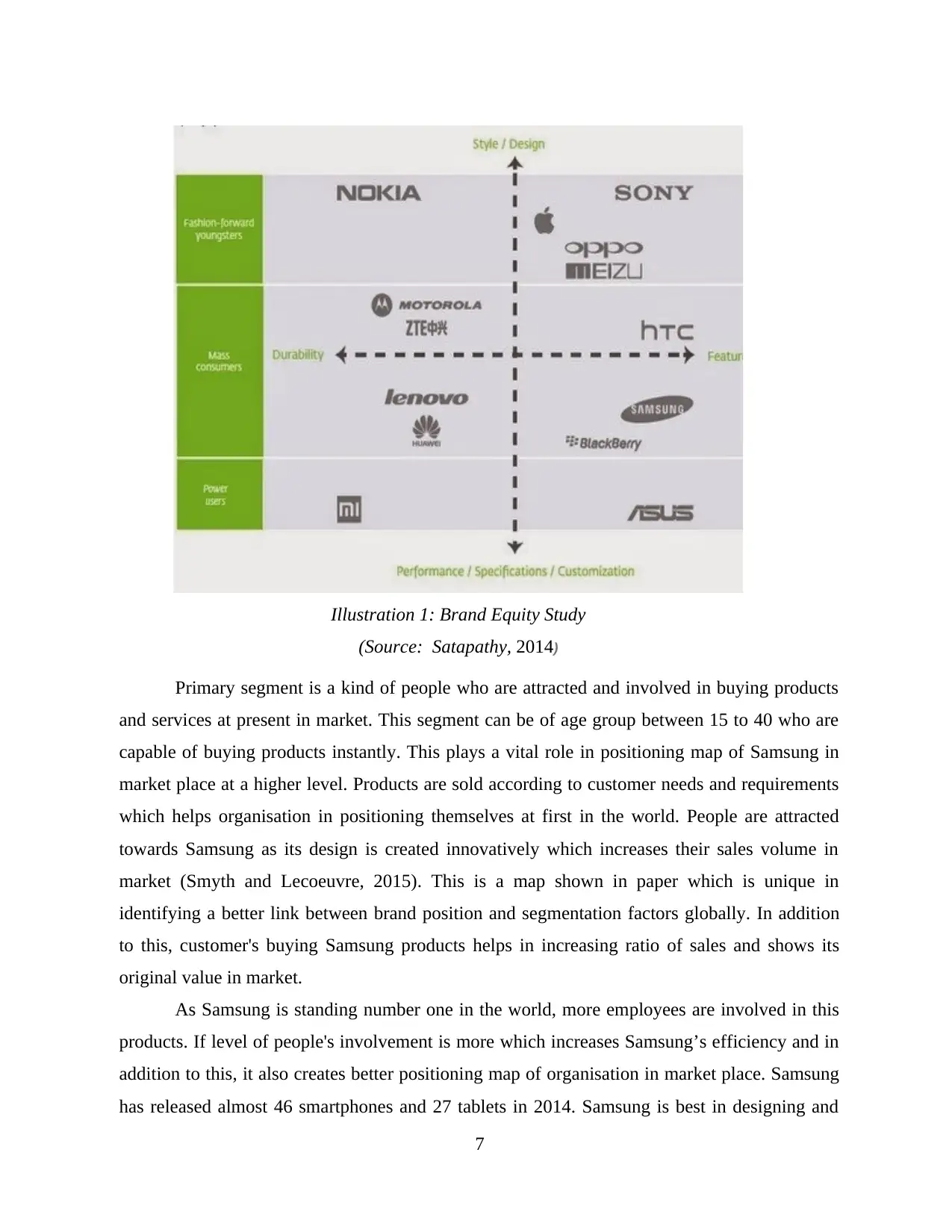
Primary segment is a kind of people who are attracted and involved in buying products
and services at present in market. This segment can be of age group between 15 to 40 who are
capable of buying products instantly. This plays a vital role in positioning map of Samsung in
market place at a higher level. Products are sold according to customer needs and requirements
which helps organisation in positioning themselves at first in the world. People are attracted
towards Samsung as its design is created innovatively which increases their sales volume in
market (Smyth and Lecoeuvre, 2015). This is a map shown in paper which is unique in
identifying a better link between brand position and segmentation factors globally. In addition
to this, customer's buying Samsung products helps in increasing ratio of sales and shows its
original value in market.
As Samsung is standing number one in the world, more employees are involved in this
products. If level of people's involvement is more which increases Samsung’s efficiency and in
addition to this, it also creates better positioning map of organisation in market place. Samsung
has released almost 46 smartphones and 27 tablets in 2014. Samsung is best in designing and
7
Illustration 1: Brand Equity Study
(Source: Satapathy, 2014)
and services at present in market. This segment can be of age group between 15 to 40 who are
capable of buying products instantly. This plays a vital role in positioning map of Samsung in
market place at a higher level. Products are sold according to customer needs and requirements
which helps organisation in positioning themselves at first in the world. People are attracted
towards Samsung as its design is created innovatively which increases their sales volume in
market (Smyth and Lecoeuvre, 2015). This is a map shown in paper which is unique in
identifying a better link between brand position and segmentation factors globally. In addition
to this, customer's buying Samsung products helps in increasing ratio of sales and shows its
original value in market.
As Samsung is standing number one in the world, more employees are involved in this
products. If level of people's involvement is more which increases Samsung’s efficiency and in
addition to this, it also creates better positioning map of organisation in market place. Samsung
has released almost 46 smartphones and 27 tablets in 2014. Samsung is best in designing and
7
Illustration 1: Brand Equity Study
(Source: Satapathy, 2014)
⊘ This is a preview!⊘
Do you want full access?
Subscribe today to unlock all pages.

Trusted by 1+ million students worldwide

providing various features in their products which attracts more people in market. Samsung is
standing on first position as its gross is higher which is almost $6500 in five minutes. This
organisation has made almost $2 million in its products and services (Lei and Moon, 2015). As
per research, 74% of people are influenced by others in purchasing Samsung’s products in
market. In addition to this, 68% of people are buying Samsung’s products online through
internet. Customers are attracted more towards this smartphones, laptop, household items of
Samsung which is best for the organisation. Almost 85% of people are involved in this
smartphone company.
Moreover, level of competition of Samsung organisation is also at peak. This firm is
standing at first position in market place compared to other brands. Samsung deals in
electronics as well as in different communicating systems (Nielsen and et.al, 2015). Also
compared to I-phone, Samsung provides better designs and features to customer's. Lastly,
product of Samsung is sold environment- friendly as compared to other companies.
CONCLUSION
From above report it can be concluded that as compared to other companies, Samsung
stands on first position in selling their products and services in market place. In addition to this,
it has been analysed that from different products of Samsung, smartphones are demanded more
and has a great impact on people. According to PESTLE analysis, environment is a best
analytical part because Samsung’s products are sold in eco-friendly environment to customers.
Moreover, it has been analysed that strength of Samsung is to create new designs and features in
smartphones. Lastly, from positioning map of Samsung it can be said that most of the people are
using devices of this organisation.
8
standing on first position as its gross is higher which is almost $6500 in five minutes. This
organisation has made almost $2 million in its products and services (Lei and Moon, 2015). As
per research, 74% of people are influenced by others in purchasing Samsung’s products in
market. In addition to this, 68% of people are buying Samsung’s products online through
internet. Customers are attracted more towards this smartphones, laptop, household items of
Samsung which is best for the organisation. Almost 85% of people are involved in this
smartphone company.
Moreover, level of competition of Samsung organisation is also at peak. This firm is
standing at first position in market place compared to other brands. Samsung deals in
electronics as well as in different communicating systems (Nielsen and et.al, 2015). Also
compared to I-phone, Samsung provides better designs and features to customer's. Lastly,
product of Samsung is sold environment- friendly as compared to other companies.
CONCLUSION
From above report it can be concluded that as compared to other companies, Samsung
stands on first position in selling their products and services in market place. In addition to this,
it has been analysed that from different products of Samsung, smartphones are demanded more
and has a great impact on people. According to PESTLE analysis, environment is a best
analytical part because Samsung’s products are sold in eco-friendly environment to customers.
Moreover, it has been analysed that strength of Samsung is to create new designs and features in
smartphones. Lastly, from positioning map of Samsung it can be said that most of the people are
using devices of this organisation.
8
Paraphrase This Document
Need a fresh take? Get an instant paraphrase of this document with our AI Paraphraser

REFERENCES
Books and Journals
Ellis, D. and Caruana, A., 2018. Consumer wine knowledge: components and segments.
International Journal of Wine Business Research, (just-accepted), pp.00-00.
Ferrell, O.C., Lucas, G.H. and Bush, A.J., 2015. Distinguishing Market Segments to Assess
Price Responsiveness. In Proceedings of the 1988 Academy of Marketing Science (AMS)
Annual Conference (pp. 261-265). Springer, Cham.
Hernández-Méndez, J. and et.al, 2015. The influence of e- word-of-mouth on travel decision-
making: consumer profiles. Current issues in tourism 18(11) pp.1001-1021.
Lei, N. and Moon, S.K., 2015. A Decision Support System for market-driven product
positioning and design. Decision Support Systems 69 pp.82-91.
Luoma, J., 2016. Model-based organizational decision making: A behavioral lens. European
Journal of Operational Research 249(3) pp.816-826.
Morselli, A., 2015. The decision-making process between convention and cognition. Economics
& Sociology 8(1) p.205.
Narasimhan, L., Srinivasan, K. and Sudhir, K., 2015. Marketing science in emerging
markets. Marketing Science 34(4) pp.473-479.
Nayeem, T. and Casidy, R., 2015. Australian consumers' decision-making styles for everyday
products. Australasian Marketing Journal (AMJ) 23(1) pp.67-74.
Nielsen, L.B. And et.al, 2015. March. Management accounting and decision making:
Two case studies of outsourcing. In Accounting Forum (Vol. 39, No. 1, pp. 64-82).
Elsevier.
Nuss, C., 2015. May. Developing an Environmental Management Information System to Foster
Sustainable Decision-Making in the Energy Sector. In ECIS.
Sampath, S., and et.al, 2015. A decision-making framework for project portfolio planning at
Intel Corporation. Interfaces 45(5) pp.391-408.
Schaper, M. ed., 2016. Making ecopreneurs: developing sustainable entrepreneurship. CRC
Press.
Smyth, H. and Lecoeuvre, L., 2015. Differences in decision-making criteria towards the return
on marketing investment: A project business perspective. International Journal of
Project Management 33(1) pp.29-40.
9
Books and Journals
Ellis, D. and Caruana, A., 2018. Consumer wine knowledge: components and segments.
International Journal of Wine Business Research, (just-accepted), pp.00-00.
Ferrell, O.C., Lucas, G.H. and Bush, A.J., 2015. Distinguishing Market Segments to Assess
Price Responsiveness. In Proceedings of the 1988 Academy of Marketing Science (AMS)
Annual Conference (pp. 261-265). Springer, Cham.
Hernández-Méndez, J. and et.al, 2015. The influence of e- word-of-mouth on travel decision-
making: consumer profiles. Current issues in tourism 18(11) pp.1001-1021.
Lei, N. and Moon, S.K., 2015. A Decision Support System for market-driven product
positioning and design. Decision Support Systems 69 pp.82-91.
Luoma, J., 2016. Model-based organizational decision making: A behavioral lens. European
Journal of Operational Research 249(3) pp.816-826.
Morselli, A., 2015. The decision-making process between convention and cognition. Economics
& Sociology 8(1) p.205.
Narasimhan, L., Srinivasan, K. and Sudhir, K., 2015. Marketing science in emerging
markets. Marketing Science 34(4) pp.473-479.
Nayeem, T. and Casidy, R., 2015. Australian consumers' decision-making styles for everyday
products. Australasian Marketing Journal (AMJ) 23(1) pp.67-74.
Nielsen, L.B. And et.al, 2015. March. Management accounting and decision making:
Two case studies of outsourcing. In Accounting Forum (Vol. 39, No. 1, pp. 64-82).
Elsevier.
Nuss, C., 2015. May. Developing an Environmental Management Information System to Foster
Sustainable Decision-Making in the Energy Sector. In ECIS.
Sampath, S., and et.al, 2015. A decision-making framework for project portfolio planning at
Intel Corporation. Interfaces 45(5) pp.391-408.
Schaper, M. ed., 2016. Making ecopreneurs: developing sustainable entrepreneurship. CRC
Press.
Smyth, H. and Lecoeuvre, L., 2015. Differences in decision-making criteria towards the return
on marketing investment: A project business perspective. International Journal of
Project Management 33(1) pp.29-40.
9
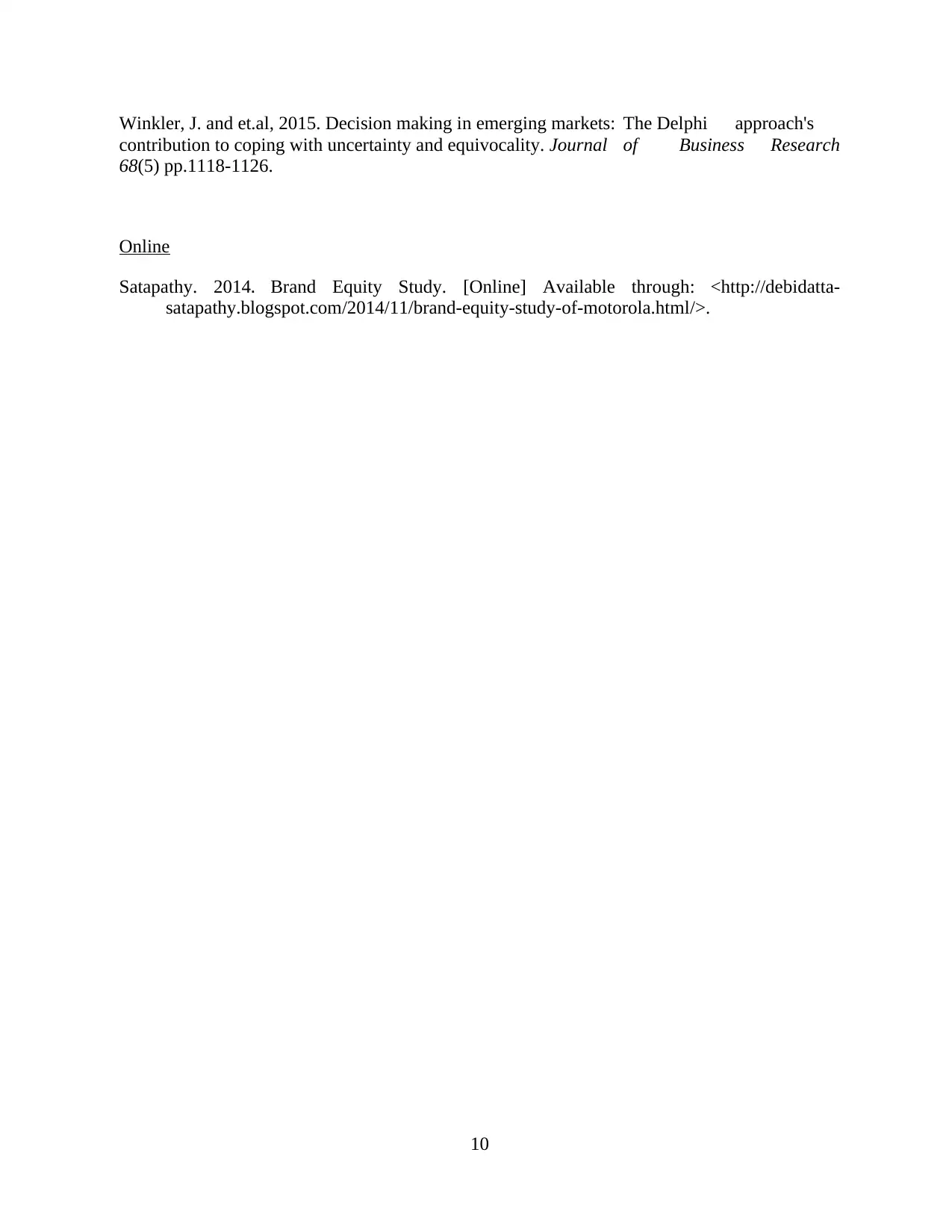
Winkler, J. and et.al, 2015. Decision making in emerging markets: The Delphi approach's
contribution to coping with uncertainty and equivocality. Journal of Business Research
68(5) pp.1118-1126.
Online
Satapathy. 2014. Brand Equity Study. [Online] Available through: <http://debidatta-
satapathy.blogspot.com/2014/11/brand-equity-study-of-motorola.html/>.
10
contribution to coping with uncertainty and equivocality. Journal of Business Research
68(5) pp.1118-1126.
Online
Satapathy. 2014. Brand Equity Study. [Online] Available through: <http://debidatta-
satapathy.blogspot.com/2014/11/brand-equity-study-of-motorola.html/>.
10
⊘ This is a preview!⊘
Do you want full access?
Subscribe today to unlock all pages.

Trusted by 1+ million students worldwide
1 out of 12
Related Documents
Your All-in-One AI-Powered Toolkit for Academic Success.
+13062052269
info@desklib.com
Available 24*7 on WhatsApp / Email
![[object Object]](/_next/static/media/star-bottom.7253800d.svg)
Unlock your academic potential
Copyright © 2020–2025 A2Z Services. All Rights Reserved. Developed and managed by ZUCOL.




